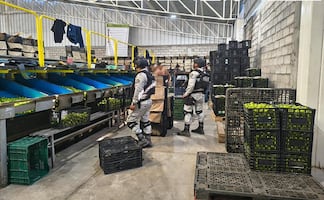Más Información

FGR investiga caja negra del Tren Interoceánico y concluye necropsias; despliega peritos en 13 especialidades

A 50 días del Plan Michoacán, detienen a 278 personas; realizan recorridos a empacadoras e industrias cítricas

Prueba piloto para afiliar a trabajadores de plataformas digitales aún no termina, explica IMSS; acciones continúan, dice

Detienen y vinculan a proceso Alejandro Baruc “N” en Uruapan, Michoacán; podría estar relacionado con el asesinato de Carlos Manzo

Emiten alerta en seis estados por robo de cilindro con gas cloro; advierten por alto nivel de toxicidad
In accordance with two of the guiding principles of its foreign policy— non-proliferation regime and peaceful conflict resolution — Mexico welcomed in 2015 the successful negotiation of the Iran nuclear deal in Vienna , Austria .
The historic Joint Comprehensive Plan of Action ( JCPoA ), reached between Iran and the P5+1 group (the permanent members of the United Nations Security Council , plus Germany ) “testifies the effectiveness of diplomacy and multilateralism,” according to a statement released by Mexico’s Ministry of Foreign Affairs ( SRE ) in which the country manifested the hope that the deal would bring to the development of the Islamic Republic of Iran , the stability of the Middle East , and the maintenance of international peace and security.
Mexico’s Ministry of Foreign Affairs reiterated the inherent right of every State to the peaceful use of nuclear energy and added that the agreement “will give more transparency and increase the certainty” of the international community about the Iranian nuclear program, under the international laws on disarmament and nuclear non-proliferation.
It is worth pointing out that Mexico was a pioneer of non-proliferation during the Cold War . Meeting in Mexico City on 1967 , the national delegations of Latin America and the Caribbean drafted the Tlatelolco Treaty for the prohibition of nuclear weapons in the region.
This was the first time such a ban was put in place over such a vast, populated area and the architect of the treaty, Mexican diplomat Alfonso García Robles , received the Nobel Peace Prize in 1982 for his efforts in promoting it.
The Tlatelolco Treaty is embodied in the OPANAL ( Agency for the Prohibition of Nuclear Weapons in Latin America and the Caribbean ) and back in February 14 , 2018 , its 33 member states issued a communiqué on the 51 anniversary of the adoption of the treaty stressing that it has served as a source of inspiration for four other regions: the South Pacific ( 1986 ), Southeast Asia ( 1997 ), Africa ( 2009 ), and Central Asia ( 2009 ), as well as Mongolia , which unilaterally declared itself nuclear-free in 2000 .
“Militarily denuclearized zones do not constitute an end in themselves, but rather a highly relevant intermediary step towards the realization of nuclear disarmament and general and complete disarmament under effective international control”, the member states said.
Active member
As a member of the International Atomic Energy Agency ( IAEA ), Mexico has also promoted other instruments on the matter, such as the Treaty on the Non-Proliferation of Nuclear Weapons ( NPT ), the Comprehensive Nuclear-Test-Ban Treaty ( CTBT ), and the Treaty on the Prohibition of Nuclear Weapons of 2017 .
On the field of nuclear energy , the country has developed as well a proactive policy, exemplified by the signing of the U.S.-Mexico Cooperation Agreement for the Peaceful Use of Nuclear Energy on May 8, 2018 , during the meeting in Washington between Mexico’s Foreign Minister Luis Videgaray , and the U.S. State Department Secretary Mike Pompeo .
The agreement, Videgaray said, will allow both countries to continue strengthening its cooperation in the area of technological transfers, “so that the next governments of Mexico can continue to develop the use of nuclear technology for medical purposes or for the generation of electricity if that is decided in the future.”
For its part, Pompeo highlighted that the deal “further expands our relationship and will benefit the North American and U.S. suppliers in the nuclear energy industry .”
Laguna Verde
Laguna Verde
, the only nuclear power plant in Mexico, is located on the coast of the Gulf of Mexico, in Alto Lucero , Veracruz . Unit 1 started its operation in 1990 , followed five years later by Unit 2 .
The plant, owned and operated by Mexico’s Federal Electricity Commission ( CFE ), produces about 4% of the country’s electrical energy and consists of two GE Boiling Water Reactors ( BWR-5 ) each one with installed capacity of 682 MW using low enriched uranium ( 3% ) as fuel. Their operating life was extended to 40 years in 2013.
The report " Nuclear Power in Mexico " by the World Nuclear Association said last year that back in 2010 CFE had four scenarios for new power generation capacity from 2019-2028 , including a low-carbon scenario “that calls for big investments in nuclear and wind power.”
Under the CFE’s most aggressive scenario, up to ten nuclear power plants would be built so that nuclear energy supplied nearly a quarter of Mexico’s power needs by 2028 , which would allow the country’s carbon emissions from power generation to remain virtually unchanged from 2028 despite projections of substantially higher demand.
However, a decision on building new nuclear capacity has been delayed, the report added.
Edited by
More by
Noticias según tus intereses
[Publicidad]
[Publicidad]










